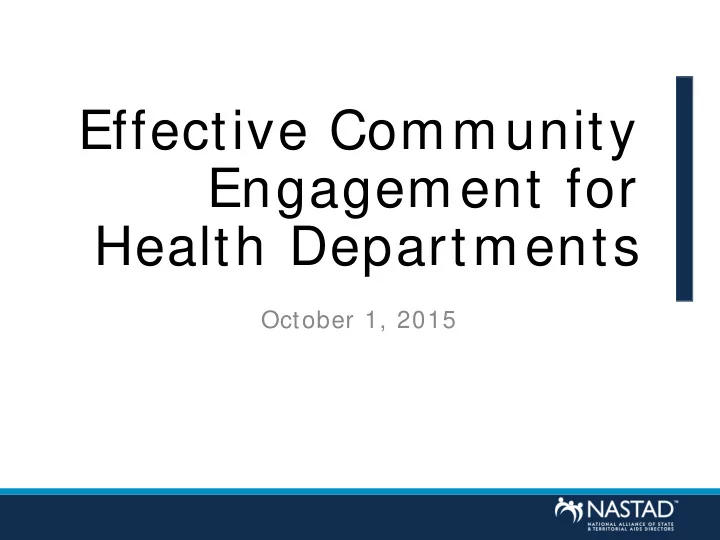

Effective Community Engagement for Health Departments October 1, 2015
Webinar Agenda Tim e Topic Presenter 3: 00-3: 10 NASTAD’s Work on Todd Harvey Community Engagement NASTAD 3: 10-3: 20 Community perspective Darion Banister Nashville CARES 3: 20-3: 40 Health Department HIV Lydia Guy-Ortiz Planning & Social Action Washington State Department of Health 3: 40-4: 00 Q&A
Webinar Objectives • Describe NASTAD’s call to implement enhanced health department community engagement strategies • Provide examples of meaningful community engagement from community members • Describe a health department model that diversifies opportunities for community engagement • Provide opportunity to discuss innovative paths to community engagement
What Does Community Engagement Mean to You?
Methods of Community Engagement Pre-Webinar Survey: Community Engagement Methods Community planning group 93% Focus groups 65% Special stakeholder groups 62% Social media 51% Town halls 32% Other 22% User-generated content 19%
Accountability to Community
Package of Community Engagement Tools Community engagement HIV Planning Social Action
Nature of the Planning Social Action Challenge Technical Correct power Solution expertise imbalance Challenge power Activity Task-oriented imbalance Injustices, privilege, Language Statistics, deficits rights, access Role of Facilitator, Health Leader participant Departm ent
Paths to Engage • Author and distribute policy statements • Create educational materials • Modernize state administrative rules • Engage with advisory groups in an ongoing manner • Create Equity and Social Justice Reports & Factsheets • (co)Author op-Eds and Letters to the Editor • Participate in outside coalitions
Policy Drives Health • Resource allocation to communities needing services • Access to PrEP and nPEP • Quality housing programs • Jobs, employment non-discrimination • Access to substance use and mental health services • Insurance support • Sexuality Education • HIV Criminalization
Community Engagement • HIV Prevention Specialist: Social Network Strategy, Nashville Cares • NASTAD Youth Ambassador
Community Engagement Campaigns Speak Out: 25 Under 25 CAPUS NASTAD Youth Ambassadors
Incorporating Activism into HIV Planning Washington State Lydia Guy Ortiz Community Planning Coordinator
HIV Planning Steering Group • Formal standing advisory group • Frequency – bi-monthly, in person • Facilitated by DOH designated HIV Planner
Social Planning
HIV Stakeholder Village • No formal membership • Open to everyone • Frequency - similar in number to HPSG • In coordination with local organizations • Topics same as HPSG • Varied formats
HIV Special Emphasis Workgroups • Subject Matter Experts • Invitation/Recommendation • Frequency – variable • Coordinated with local organizations • Varied formats • Convened to date – HIV Related Health Disparities – Behavioral Interventions-PrEP – Clinical Services
Social Action
Our response to the challenge Social Social Action Planning
#Bla lackLiv ivesMa sMatt tter
HIV-related health disparities do not exist in isolation. They are part of a larger system of inequities which exist. They are compounded and exacerbated by one’s daily experiences of injustice. As the HIV-Related Health Disparities Special Emphasis Workgroup (Health Disparities SEW) convened as part of the Washington State HIV Planning System we recognize our role in identifying and proposing strategies directly related to the provision of HIV related services. However, it is our belief that achieving the vision described in the National HIV /AIDS Strategy will require a paradigm shift. It will require a social justice approach that looks not only at specific indicators of inequality but also attempts to address issues broadly associated with the social determinants of health. HIV-Related Health Disparities Special Emphasis Workgroup Washington State Department of Health
Contact Info Lydia Guy Ortiz Washington State Department of Health lydia.guy-ortiz@doh.wa.gov
Questions • Verbal Questions o Press * 7 to unmute o Press * 6 to re-mute o Please identify yourself • Written Questions o Submit using chat • If you have questions regarding this webinar, please contact Erin Bascom (ebascom@NASTAD.org)
THANK YOU!
Recommend
More recommend